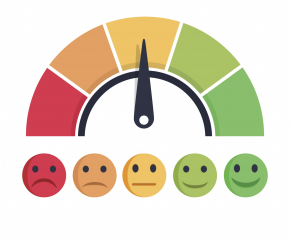Creating happy. Avoiding angst.
Tips from a long-time industry veteran.
In today’s “instant” society filled with all of the “about me” and “right now” expectations, how can you know what is important to your customer? How do you understand what they know, what they want, and what they feel? There is only one way–ask and listen.
What makes customers upset?
A dissatisfied customer can be quick to shoot arrows via social media and online reviews. Sometimes they are warranted, sometimes not. Rest assured they are always the result of poor communication of some kind.
When a customer does not fully understand your processes, your methods and the idiosyncrasies of your business, this lack of understanding can lead to conflict. Having been in the heating and air industry for over 30 years, there were many times a customer was frustrated due to scheduling problems. For example, a customer who takes off work expecting the service technician to arrive at 1:00PM will be upset if the technician does not arrive until 4:30PM.
The technician, who has been working hard in the heat of summer since 7:00AM on his first call may be less than civil when confronted with the angry homeowner. In the technician’s defense, he didn’t know when he started that morning that his first call would take nine hours. He becomes so focused on completing his first job that he doesn’t think to call his second customer and tell them he will be delayed.
It is this lack of communication that can lead to damaged customer relationships and poor reviews. Once the technician shows up, no matter what a wonderful job he does repairing the A/C, the client will be upset at losing a half day’s work. Unless the customer is placated in some manner, they are likely to leave a less than stellar review.
How to avoid it
It is important to have systems in place to track and prevent situations that may lead to customer dissatisfaction. A phone call to the above customer may have allowed them to work later in the day, therefore lessening the inconvenience of taking off work. A dispatcher who is made aware of the additional time requirement can shuffle schedules and contact customers to reduce or prevent conflict. A technician who thinks ahead can forewarn the office and/or customer so other arrangements can be made. Never does the old adage ring truer than when it comes to proactive, good communication: “An ounce of prevention is worth a pound of cure.”
But even when the company tries to do everything right, occasionally things go wrong. We are all human and sometimes make mistakes. When we are hot, harried, and hurried, we tend to make more mistakes than usual. What should you do when the inevitable mistake happens? There are four critical steps that should be taken:
4 ways to handle customer dissatisfaction
First off, as always, listen before you speak. Even if the customer is angry, listen carefully to every word, while coaching yourself, if needed, in order to remain calm. Never interrupt an angry customer. Allow them to continue until they have it worked out of their system. (The one exception to this is if the customer is vulgar or being verbally abusive.)
When they have finished venting their frustration, then apply the following:
- Admit you have made a mistake. Taking responsibility for our behavior is a lost art nowadays. “Mr. Homeowner, thank you for what you shared and I absolutely agree that we should have communicated better, and should have arrived in the agreed upon timeframe. As your technician, I take personal responsibility for that.” How’s that for wow factor!
- Apologize verbally for your mistake. “I truly apologize for our lack of communication today and for keeping you waiting so long.” Now, in all fairness, sometimes mistakes are merely perceived to be mistakes in the customer’s mind. In those cases, there’s no need for a false admission of guilt, but there is still plenty you can do to help the customer feel valued and heard. For example, show empathy, express appreciation, or valide the customer’s concerns—sometimes all three. For example, “Thank you so much for your patience today. I know how hard it is to be without heat (or power, or plumbing), and to be waiting for someone to come.” No admission of guilt there, but very conciliatory, non-inflammatory language that should help diffuse high emotion.
- Ask the customer what can be done to amend for your mistake. Usually, just having the opportunity to vent will help make amends. I have found that the customer will usually ask for less than I would have been willing to give to repair the relationship. Occasionally you will come across someone who will be unreasonable, but the majority of the people will be very fair with you.
- Apologize tangibly for your mistake. Send an apology gift. You can turn a negative experience into a positive one by expressing both regret and appreciation at the same time, with an unexpected gift mailed directly to the customer. Something as simple as a sweet gift of freshly baked cookies or candy can remove a customer’s sour or bitter feelings toward your company.
In this Forbes article there are some great tips for apologizing to customers. I love how they say to avoid the “fakey fake” apology and how to apologize without alienating your employees. So important, because your employees are your internal customers.
Your Next Step
Good communication is linked to higher customer satisfaction. But communication prowess doesn’t come naturally to a lot of people. So make communication training a priority for you and your team–your CSRs, salespeople, technicians, managers, and yourself. You may have the vision for a company with excellent communication skills, but bestowing your vision on your team always takes hard work and intentionality. For starters, see our article, “Becoming a Customer-obsessed Contractor”. In it, we talk at length about how to transfer your personal vision, attitude and culture, onto your team.
To Your Success!
Steve







